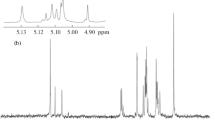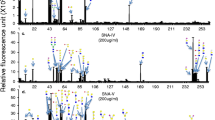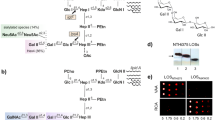Abstract
Mannosylerythritol lipids (MEL), which are glycolipid biosurfactants secreted by the Pseudozyma yeasts, show not only excellent surface-active properties but also versatile biochemical actions including antitumor and cell-differentiation activities. In order to address the biochemical actions, interactions between MEL-A, the major component of MEL, and different lectins were investigated using the surface plasmon resonance spectroscopy. The monolayer of MEL-A showed high binding affinity to concanavalin A (ConA) and Maackia amurensis lectin-I (MAL-I). The observed affinity constants for ConA and MAL-I were estimated to be 9.48 ± 1.31 × 106 and 3.13 ± 0.274 × 106 M−1, respectively; the value was comparable to that of Manα1–6(Manα1–3)Man, which is one of the most specific probe to ConA. Significantly, α-methyl-D-mannopyranoside (1 mM) exhibited no binding inhibition between MEL-A and ConA. MEL-A is thus likely to self-assemble to give a high affinity surface, where ConA binds to the hydrophilic headgroup in a different manner from that generally observed in lectin-saccharide interactions. The binding manner should be related with the biochemical actions of MEL toward mammalian cells via protein-carbohydrate interactions.






Similar content being viewed by others
References
Cooper MA, Try AC, Carroll J, Ellar DJ, Williams DH (1998) Surface plasmon resonance analysis at a supported lipid monolayer. Biochemica et Biophisica Acta 1373:101–111
Gorldstein IJ, Hollerman CE, Merrick JM (1965) Protein-carbohydrate interaction. I. The interaction of polysaccharides with concanavarin A. Biochemica et Biophysica Acta 97:68–79
Hamelryck TW, Loris R, Bouckaert J, Wyns L (1998) Structural features of the legume lectins. Trend Glycosci Glycotech 55:349–360
Hernaiz MJ, de la Fuente JM, Barrientos AG, Penades S (2002) A Model System Mimicking Glycosphingolipid Clusters to Quantify Carbohydrate Self-Interactions by Surface Plasmon Resonance. Angew Chem Int Ed 41:1554–1557
Im JH, Ikegami T, Yanagishita H, Takeyama Y, Idemoto Y, Koura N, Kitamoto D (2003) Mannosylerythritol lipids, yeast glycolipid biosurfactants, are potential affinity ligand materials for human immunoglobulin G. J Biomed Mater Res 65:379–385
Imura T, Yanagishita H, Ohira J, Skaki H, Abe M, Kitamoto D (2005) Thermodynamically stablevesicle formation from glycolipid biosurfactant sponge phase. Colloids and Surfaces B: Biosurfaces 43:114–121
Imura T, Ohta N, Inoue K, Yagi N, Negishi H, Yanagishita H, Kitamoto D (2006) Naturally engineered glycolipid biosurfactants leading to distinctive self-assembled structures. Chem Eur J 12:2434–2440
Karlsson R, Michaelsson A, Mattoson L (1991) Kinetic analysis of monoclonal antibody-antigen interactions with a new biosensor based analytical system. J Immunol Meth 145:229–240
Kitamoto D, Isoda H, Nakahara T (2002) Functions and potentioal applications of glycolipid biosurfactants –from energy-saving materials to gene delivery carriers-. J Biosci Bioeng 94:187–201
Lang S (2002) Biological amphiphiles (microbial biosurfactants). Curr Opin Colloid Interface Sci 7:12–20
Mann DA, Kanai M, Maly DJ, Kiessling LL (1998) Probing low affinity and multivalent interactions with surface plasmon resonance: ligands for concanavalin A. J Am Chem Soc 120:10575–10582
Morita T, Konishi M, Fukuoka T, Imura T, Kitamoto D (2006a) Discovery of Pseudozyma rugulosa NBRC 10877 as a novel producer of the glycolipid biosurfactants, mannosylerythritol lipids, based on rDNA sequence. Appl Microbiol Biotechnol (in press) DOI: 10.1111/j.1567-1364.2006.00154.x
Morita T, Konishi M, Fukuoka T, Imura T, Kitamoto D (2006b) Discovery of Pseudozyma rugulosa NBRC 10877 as a novel producer of glycolipid biosurfactants, mannosylerythritol lipids, based on rDNA sequence. FEMS Yeast Res. (in press) DOI:10.1111/j.1567-1364.2006.00154.x
Ohyama Y, Kasai K, Nomoto H, Inoue Y (1985) Frontal affinity chromatography of ovalbumine glycoasparagines on a concanavalin A-sepharose column. J Biol Chem 260:6882–6887
Rau U, Nguyen LA, Schulz S, Wray V, Nimtz M, Roper H, Koch H, Lang S (2005) Formation and analysis of mannosylerythritol lipids secreted by Pseudozyma aphidis. Appl Microbial Cell Physiol 66:551–559
Rodorigues L, Banat IM, Teixeria J, Oliveira R (2006) Biosurfactants: potential applications in medicine. J Antimicrob Chemothera 57:609–618
Rudiger H (1998) Plant lectins-More than just tools for glycoscientists: Occurrence, structure, and possible functions of plant lectins. Acta Anatom 161:130–152
Siebert HC, Vonder Lieth CW, Dong X, Reuter G, Schauer R, Gabius HJ, Viegenthart JFG (1996) Molecular dynamics-derived conformation and intramolecular interaction analysis of the N-acetyl-9-O-acetylneuraminic acid-containing G(Dla) and NMR-based analysis of its binding to a human polyclonal immunoglobulin G fraction with selectivity for O-acetylated sialic acids. Glycobiology 6:561–572
Smith AE, Thomas WD, Kiessling LL, Robert MC (2003) Surface plasmon resonance imaging studies of protein-carbohydrate interactions. J Am Chem Soc 125:6140–6148
Trouganos A, Stassinopoulou CI (1994) Mode of association of concanavalin A with α-D-glycosides. Biochem Biophys Act 1206:215–224
Van Damme EJM, Peumans WJ, Barre A, Rouge P (1998) Plant lectins: A composite of several distinct families of structurally and evolutionary related proteins withe diverse biological roles. Crit Rev Plant Sci 6:575–692
Vankar YD, Schmidt RR (2000) Chemistry of glycosphingolipids-carbohydrate molecules of biological significance. Chem Soc Rev 29:201–216
Acknowledgement
We wish to thank Mr. S. Itoh of Tokyo University of Science for his kind instruction on SPR study. We also would like to thank Ms. A. Sugimura, a fellow of the Japan Industrial Technology Association, for her technical assistance. This work was supported by the Industrial Technology Research Grant Program in 05A33008c from the New Energy and Industrial Technology Development Organization (NEDO) of Japan.
Author information
Authors and Affiliations
Corresponding author
Rights and permissions
About this article
Cite this article
Konishi, M., Imura, T., Fukuoka, T. et al. A yeast glycolipid biosurfactant, mannosylerythritol lipid, shows high binding affinity towards lectins on a self-assembled monolayer system. Biotechnol Lett 29, 473–480 (2007). https://doi.org/10.1007/s10529-006-9261-x
Received:
Revised:
Accepted:
Published:
Issue Date:
DOI: https://doi.org/10.1007/s10529-006-9261-x




